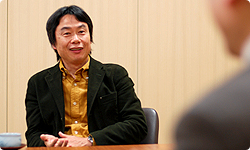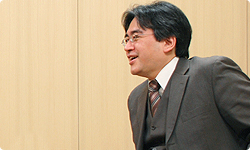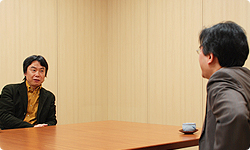2. The ''process'' as the reward
So what made you decide to use Zelda in the creation of FPS bridge-building software?
Well, once we finished Ocarina of Time, we decided to make Majora’s Mask6 as a kind of side story. 6 Majora’s Mask, part of the Legend of Zelda series, was released for the Nintendo 64 a year and a half after Ocarina of Time, in November 2000
Oh right, I remember that. When I first heard of the idea for Link’s Crossbow Training it really reminded me of Majora’s Mask. I remember thinking that it was aiming to make use of the game world and game system of Twilight Princess in a different setting7. 7 Twilight Princess, part of the Legend of Zelda series, was released for the Nintendo GameCube and Wii in December 2006
Yeah, that’s true. The terrain created for Twilight Princess was vast. And honestly, I really thought there was more we could do with it. Those sort of sentiments always cross our minds in video game development though...(smiles sheepishly).
(laughs)
So, after we finished with the development of Twilight Princess, I talked to the staff about whether or not we could do a side story. With a big series like Zelda, we usually only release a new version every 3-5 years, but we thought it would be great to make something for those people that really enjoyed Twilight Princess where they’d be able to keep playing in the same world. I think it’s important to release products at a fairly fast pace.

On the other hand, it’s also probably important to keep the development pace moving for the sake of developers as well, right?
That’s true. So, I asked our Zelda staff to think about a new project with an extra story based around Twilight Princess. But then, they were coming up with stories that can be described as ‘epic tales’ rather than ‘side stories’.
And the people have to wait 3-5 years for it again?
Of course it’s also important to continue creating epics, but I do not believe that an epic tale alone can make a great game. I mean, depending on what kind of characteristics are added to a game, the fundamental enjoyment behind it can get lost amongst all the gadgets. With that in mind, we took some time to ponder over the new project and ultimately suggested that we make a game based on Twilight Princess that utilised the Wii Zapper.
I will ask you about the Wii Zapper, but what was the staff’s reaction when you proposed that idea?
They were kind of shocked. It was like killing all the ideas they were working with until then. Some even felt that we should not do something which makes it look like we are reusing the already existing software and selling it to the consumers.
Well, at the beginning of the project, even I sensed an air of disagreement, or at least a lack of understanding, amongst some of the staff.
Which is why I proposed to them that we make a working prototype and ask our test players to play and let us know their impressions. If they told us that it wasn’t fun, we’d stop development right there.
And what was the reaction of the test players?
It was great. Nintendo of America got together a group including a number of die-hard Zelda fans, but none of them said ‘What? This isn’t Zelda!’, and they started really enjoying the game, and we knew that it was a go. After that, we received daily reports on the product that allowed us to tweak aspects of it as we continued working on it.
I was the one who initially conveyed the idea for Link’s Crossbow Training to people at Nintendo of America when I was on a business trip there, and they told me they were pretty worried about the project. I mean, they had to wonder ‘Is it ok to tinker with a product as popular and important as Zelda?’, but as soon as they received the prototype, such anxiety apparantly disappeared, as I have not heard of any more concerns from them since then.

Well, everyone likes video games. Even if you have a preconceived idea of what things a game should have in it, when it comes down to it, as long as the game is fun it really won’t make much of a difference. For this matter, I intentionally ordered our team a number of “don’ts” in the game’s development.
What do you mean by that?
Like, we cannot include anything unnecessary or we cannot make a movie, or the player should be able to complete one stage within three minutes.
Interesting (laughs).
For example, just for argument's sake, let’s say that it takes 10 minutes to finish one thing in the game – you might not feel like trying to do it again if you fail. The longer you play, the more you should get into it. So if something only takes you three minutes to complete, you’ll still want to try it again if you mess up.
Definitely, if you think you’re going to keep getting better at the game, you’re going to want to keep playing it.
There are lots of reasons for playing video games; because you want to get to the next level, or because you want to see what the next boss you have to fight looks like. I’m told all the time that these kinds of “rewards” really matter to people. But I don’t think that’s necessarily true. What I’m always saying, not only regarding Link’s Crossbow Training, but in general too, is that it’s the process that must be fun for people if they’re going to really enjoy the game.
So you mean if the “journey” is fun, then the ending, or the result, really doesn’t matter?
Yeah. The fact is, the journey is really the reward. And there are times when game creators use well-made “rewards” as the excuse. For example, if someone invents an ending that they’re really proud of, that they just think is fantastic, then they might end up settling for a less-than-splendid journey. But that’s a definite case of getting your priorities mixed up. So with Link’s Crossbow Training, I really saw it as my responsibility to make sure that the creators didn’t get too caught up in the end, and focused instead on making the journey itself the fun part. I even told them not to make any bosses.

No bosses? Really?
I really wanted them to put all their energy into making the journey fun rather than making these fabulous bosses. Even so, at the end we had one boss - I finally gave in because they kept bugging me to let them make three bosses (laughs). As there was only one boss, they could concentrate their time and energy working only on it, instead of on three bosses.
So, basically, I get the impression that the key message you want to relay here with the current project is that it’s not the destination, but the journey that really matters.
Yeah, that’s a phrase that I’ve adhered to recently, so I really tried to make use of it (laughs).
So, in order to make the journey through the game fun, what specifically did you do?
Well, basically the goal was to get people to use the software with the Wii Zapper and think, ‘wow, the Wii Zapper is really easy and fun to use’. So, simply aiming and shooting at a target is fine, but we have also included a number of tricks within demo screens. That way, every time you play you figure out something new about the game, and then you want to keep playing. And whether or not you can get high scores depends on how you get to grips with some of the hidden challenges involved.
Because you can’t get a high score by just shooting haphazardly, right?
Yeah, you really have to think about how you can keep raising your score.
That aspect of the game sounds like quintessential Zelda.
And the staff always wanted to make something more than just another shooting game, so they were really into making something unique. For example, when a path splits and you can choose your route, they might put certain objects...
Well, let’s not spoil the surprise for the people who haven’t played it yet! (laughs). Ok, now let’s move on to the topic of the Wii Zapper.